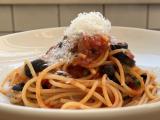Gazpacho
Table of Contents
Jump to Recipe
Jump to Carbon Footprint
During the summer of 2022, an unprecedented heatwave swept across Europe. It is alarming to experience such extreme temperatures, which were not expected until 2050. Despite our efforts to cool ourselves and our apartment, the temperature never drops below 20°C at night.
Fortunately, our Spanish friend María shared with us an effective, simple, and delicious strategy for cooling down: Keep Calm and Eat Gazpacho.

The slogan for this hot summer is: Keep calm and eat Gazpacho. (Tomato icon from Flaticon)
María is from the south of Spain, where people have long had to come up with strategies to deal with the heat. One of her measures: She always has an emergency gazpacho in the fridge. Here is her basic recipe for gazpacho - thanks María, it saved our summer. 🙏
María emphasises the importance of using good quality olive oil for the best taste. Her version does not use cucumber, but there are many variations of gazpacho in Spain. María said to us with a wink: “This is my recipe, but it’s not the only one in the world and I can live with it if you prefer other people’s reddish water.”
The chilled soup with the slightly spicy vegetables is the perfect meal on a hot summer evening. It pairs well with white bread or raw sliced vegetables as a side dish.

Recipe #
Gazpacho
10 minutes
2 portions
Ingredients #
- 700 g of tomatoes
- about 50 g of bread
- about 70 ml of olive oil
- 1/2 red bell pepper (approximately 80 g)
- about 1 tablespoon of vinegar
- 2 cloves of garlic
- about 3 g of salt
Directions #
- Wash and roughly chop the tomatoes and add them to a blender with the bread and olive oil. Allow the bread to soak up some of the tomato juice and oil for a few minutes.
- Dice the peppers and add them to the blender along with the vinegar, garlic, and salt.
- Blend all the ingredients for 8-10 minutes until creamy. If the gazpacho warms up while blending, add a few ice cubes.
- Serve cold, for example with white bread or a colourful salad. The gazpacho is even better if you keep it in the fridge overnight and eat it the next day.
Carbon Footprint #
In total, two portions of gazpacho have an estimated carbon footprint of 946 g.
This ranks it number 11 out of 57 recipes published on the blog so far in terms of estimated carbon footprint.
This means that it belongs to the quarter of recipes that have the lowest climate impact (i.e. top 25%). 🥰Compared to other soups such as Grisons barley soup with vegetables (1085 g CO2) or bulgur soup with red lentils (1152 g CO2), gazpacho causes fewer emissions.
Olive oil is the most significant contributor to the climate impact of gazpacho, accounting for almost a quarter of it, despite making up less than 10% of the ingredient weight. It takes approximately 6-7 kg of olives to produce one litre of oil. Packaging olive oil in glass bottles is relatively heavy and CO2-intensive, as the bottles are not usually recycled.
| ingredient | carbon footprint per kg | carbon footprint (in g) for 2 servings | % of ingredients | % of CO2 emissions |
|---|---|---|---|---|
| Tomatoes | 0.8 | 560 | 76% | 59% |
| Paprika | 0.6 | 48 | 9% | 5% |
| Olive oil | 3.2 | 224 | 8% | 24% |
| Vinegar | 1.4 | 14 | 1% | 1% |
| bread | 0.7 | 35 | 5% | 4% |
| Garlic | 0.4 | 2 | 1% | 0% |
| Salt | 0.7 | 2 | 0% | 0% |
| Mix for 10 minutes | 61 | 6% |


